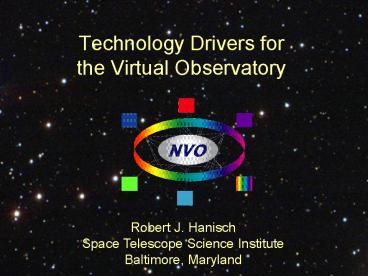Technology Drivers for the Virtual Observatory - PowerPoint PPT Presentation
1 / 20
Title:
Technology Drivers for the Virtual Observatory
Description:
type galaxies with 0.4 z 0.7. that lie within 2' of extended. x-ray emission, please! ... There are 125,852 galaxies which satisfy these criteria. What now? ... – PowerPoint PPT presentation
Number of Views:43
Avg rating:3.0/5.0
Title: Technology Drivers for the Virtual Observatory
1
Technology Drivers forthe Virtual Observatory
Robert J. Hanisch Space Telescope Science
Institute Baltimore, Maryland
2
Virtual Observatory Paradigm
- The Digital Universe requires a new kind of
observatory - The Virtual Sky comprising the distributed,
networked collection of digital data archives and
catalogs - A Virtual Telescope that gathers the data
(identifies data providers, distributes user
queries, assembles and organizes retrievals) - Virtual Instruments that process the data
(statistical and analytical algorithms,
cross-correlation visualization tools)
3
What is the VO? Content
4
What is the VO? Components
5
VO Information Technology Components
- Data management system
- Common data access layer
- Supports pipeline processing, archiving,
retrieval - Information management system
- General query and updating of attributes of
billions of objects - Metadata management
- Knowledge support system
- Correlation, visualization, statistical
comparison - Catalog data and original image pixel data
6
VO Information Technology Challenges
- Data federation and fusion
- Caching and data replication services
- Efficient indexing
- Software agents
- Metadata standards and protocols
- Metadata semantics
- Syntax for metadata exchange (XML)
- Translation, conversion, common API
- Integration with FITS
7
VO Information Technology Challenges
- Scalability
- Huge and growing datasets
- Federations and heterogeneity of huge datasets
- Accommodation for various network bandwidths
- Accommodation for computationally intensive
applications - Support for high dynamic range in usage profiles
- Data Understanding
- Data mining and statistical analysis
- Self-classification, visualization-assisted
classification - Correlation studies, non-parametric estimation
8
VO Conceptual Architecture
User Interface
Astronomer
Data
Data
Data
Data
Data
9
VO Conceptual Architecture
User Interface
Astronomer
There are 125,852 galaxies which satisfy these
criteria. What now?
Data
Data
Data
Data
Data
10
Initiating VO Present Context
- A strong foundation for building VO is in place
- Existing data- and supercomputer- centers
- HEASARC, IPAC/IRSA, STScI/HST/MAST,
CXC, CADC - NPACI, NCSA
- Active community efforts on frontier IT problems
- Astronomical information services
- ADS, NED, SIMBAD
- Data analysis software
- AIPS, IRAF, IDL, FTOOLS, Skyview, SExtractor
11
NASAs Astrophysics Data Services
... Infrared.OpticalUltravioletEUVX-ray
Gamma-ray
12
NASAs Astrophysics Data Services
... Infrared.OpticalUltravioletEUVX-ray
Gamma-ray
13
NASAs Astrophysics Data Services
... Infrared.OpticalUltravioletEUVX-ray
Gamma-ray
14
NASAs Astrophysics Data Services
... Infrared.OpticalUltravioletEUVX-ray
Gamma-ray
15
Initiating VO Key Elements
- Links with information systems research
- VO pushes technical limits in many key areas
- storage technology
- information management
- data handling
- distributed and parallel computing
- high speed networking
- data visualization and data mining
- Challenges similar in other sciences and the
private sector - Partnerships among universities, NSF, NASA,
foreign observatories and agencies, and industry
essential
16
Advanced Hardware
- Large distributed database engines with Gbyte/sec
aggregate I/O speed - High speed (gt10 Gbits/s) backbones
cross-connecting the major archives databases - Scalable computing environment with hundreds of
CPUs for statistical analysis and discovery - Petabyte mass storage capability
17
Data Volume and Bandwidth
Typical query response volume
Minimum required interconnect bandwidth
18
New Analysis Tools
- Discover new patterns through advanced
statistical methods and visualization techniques - in catalogs
- in image databases
- by comparison of catalogs and image databases
- Confront catalogs and image databases with
numerical simulations of astrophysical systems - Uploadable Application packages to minimize data
transfer
19
VO Education Public Outreach
- VO can enable broad public access to panchromatic
images and digital movies of the changing sky - The compelling nature of these images can be used
to capture public interest and advance science
literacy - Students can take and analyze data using applet
software developed for web browsers - Superb resource for designing hands-on curriculum
modules
20
Summary
- The Virtual Observatory initiative
- Ensures an evolutionary, cost-effective
exploitation of the discovery potential of large,
multi-wavelength databases - Develops the protocols, software tools and
management approaches necessary to carry out
surveys at acceptable cost - Maximizes the impact of survey efforts through
broad public access - Coordinates development of tools to query and
analyze databases - Ensures that the astronomical community has the
proper network and hardware infrastructure to
carry out its science
21
A Virtual Observatory for Data Exploration and
Discovery can be the catalyst for a New
Astronomy































